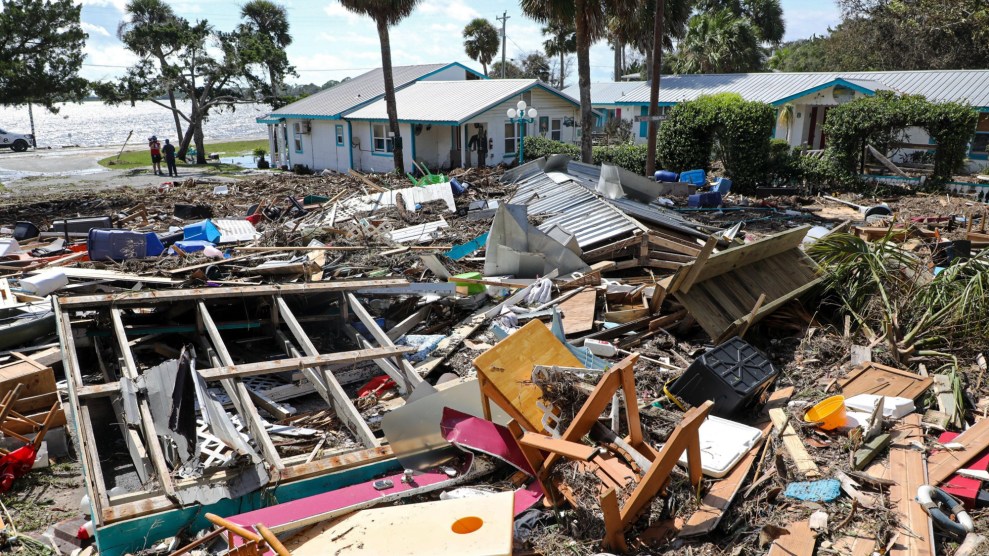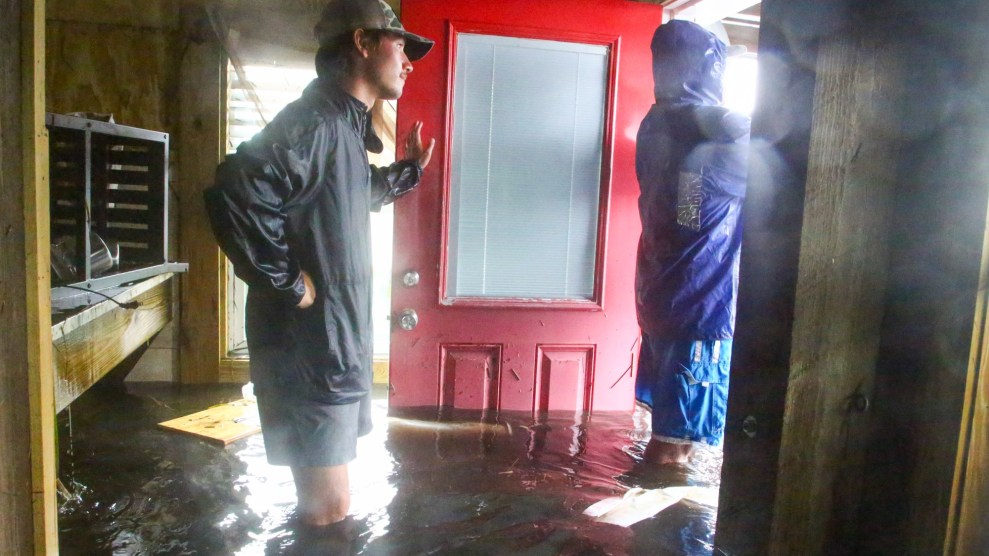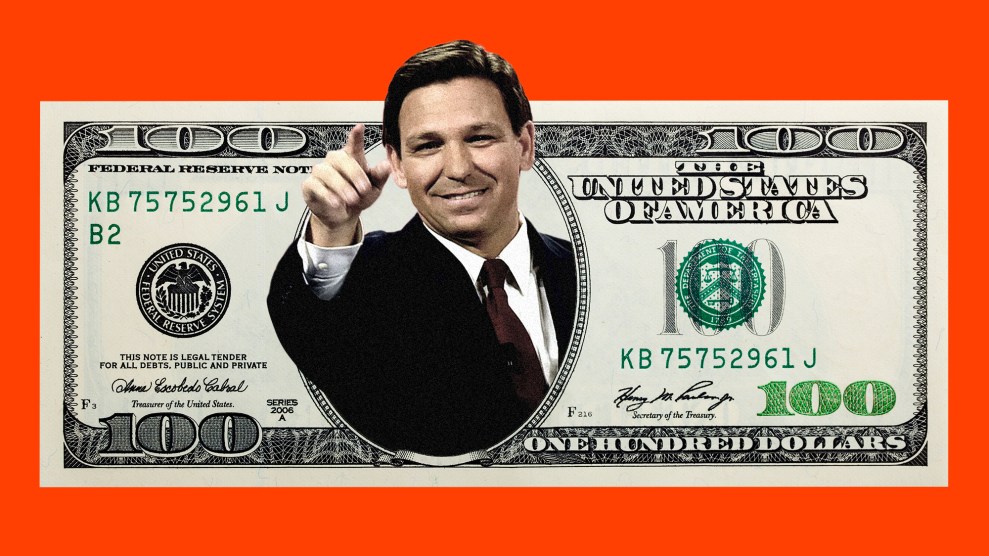
Cedar Key, Florida, took a tough hit from Hurricane Idalia. Douglas R. Clifford/AP
Hurricane Idalia, which made landfall Wednesday as a Category Three storm, left 450,000 Floridians without power and caused record-breaking storm surges and widespread flooding that locals documented on social media. Although early estimates of insured damages and economic losses are wildly preliminary, the costs in Florida alone will likely run into the billions. (AccuWeather initially estimated up to $20 billion for the wider region.)
In any case, intense storms like these are gonna cost, and someone will pay. But the identity of that someone going forward—be it insurers, homeowners, or taxpayers—is far from clear.
Florida’s insurance market has been described by experts as “very volatile.” Indeed, four national insurance companies recently pulled out of the market, and another 14 Florida firms are in liquidation, meaning they’re in the process of selling off assets to pay their creditors and shareholders. The average Florida homeowner premium at the beginning of 2023 was $4,200, AP reports, triple the national average, and more than 1 in 10 Floridians lacks property insurance vs 1 in 20 nationwide.
In a statement, Mark Friedlander, director of corporate communications for the Insurance Information Institute, an industry trade group, expressed confidence that Florida insurers will weather this storm. The firms that insure Florida homeowners, he pointed out, had purchased sufficient insurance of their own—known as “reinsurance“—in advance of the storm season: “The property/casualty insurance industry is well-capitalized to handle an expected high volume of damage claims.”
Friedlander was decidedly less optimistic in an earlier interview, telling me that “the residential insurance market in Florida is unstable—very, very unstable.” The state’s insurers are “very vulnerable to the impact of losses,” he said, “whether those are hurricane losses or their manmade losses, such as expenses related to litigation.” The risk of litigation has been reduced by recent pro-insurance legislation backed by Gov. Ron DeSantis, which makes it harder to for people to sue their insurers, but Florida is unusual, to say the least.
The state’s property insurance market, Friedlander explains, differs from those in other high-risk states such as California, which host plenty of national insurers with diverse portfolios. In Florida, by contrast, 80 percent of the market consists of state-based insurers that rely almost solely on homeowner policies, he says.
Increasingly, families have been covered by the state plan, Citizens Property Insurance Corporation. “Citizens is the largest home insurer in the state at 18 percent market share, which is unheard of,” Friedlander told me—most state plans have a market share in “the low single digits.”
Residents have enjoyed Citizens lower rates, but those rates are rising, despite recent big changes by the Florida Legislature. The state insurer nows allows private companies to take over its policies, so long as the premium stays within 20 percent of Citizens’ rate—but such a switch could result in a $500 price hike. A homeowner doesn’t have to go along, but they will be denied state coverage if they reject a comparably priced private plan.
There are also concerns about Citizens’ long-term viability. In March, DeSantis said the state plan was “not solvent,” adding, “If you did have a major hurricane hit with a lot of Citizens property holders, it would not have a lot to pay out.” In the same press conference, DeSantis, who has received $3.9 million from the insurance industry since 2018, emphasized the importance of charity and other nongovernmental sources of disaster relief. (The new legislation mandates sales tax holidays for qualifying items, such as generators, flashlights, and radios.)
Still, Florida’s retail insurers find themselves in the unenviable position of having to predict the future. As Steve Bowen, chief science officer at Gallagher Re, a global reinsurance brokerage, put it to me, the old insurance model was “to look backward and price based on stuff that happened in the past.” But old patterns no longer hold. “Now you start to take expectations of future impacts from climate and build those into an underwriting practice for the next year.”
This uncertainty makes the insurance landscape less stable, and riskier for insurers and customers alike. Multinational insurers can “absorb the losses,” Friedlander says, but smaller companies—like those that make up the Florida market, cannot. Which is why so many Florida insurers are closing their doors.
Friedlander emphasizes, however, that the broader industry has surplus capital. If clients pay their premiums, they will be covered in a crisis. Some Floridians dispute this assurance. “‘Thank God we’re insured. It will be okay,’” resident Jonathan Stettin told my colleague Abby Vesoulis sarcastically in the aftermath of last fall’s Hurricane Ian. “That turned out to be the biggest miscalculation that I ever made in my life.” Stettin said his insurance only covered about one-tenth of his losses.
Traditional homeowner plans, whether private or state, don’t pay for flood damage—a “huge gap,” Friedlander admits, given that “Florida is very vulnerable to significant flooding events.” Families must rely instead on the notoriously debt-prone National Flood Insurance Plan or specialized private insurers that are popping up as competition. Homeowners insured by the state are required to carry supplemental flood insurance, but the cost can be prohibitive—recent changes in how FEMA calculates flood risk have doubled or tripled premiums in some counties.
The high price of even the basic private and state plans—which run about $1,000 less—compel many families to forgo home insurance entirely; an estimated 12 percent of Florida households lack it, and half of them have combined incomes of less than $40,000 a year, according to a survey by Munich Re and III.
The toll from Idalia has yet to be fully tallied, but it’s not as bad as many feared. “This would be a very different event if it was going right into Tampa versus much less populated areas,” Matthew Carletti, an analyst at JMP Securities, told CNN the day before the hurricane landed.
The question now is whether the new policies put in place by insurance companies and state lawmakers can hold up to next big storm—and the one after that. If not, consumers can expect more of the same. “You get victimized twice,” as Stettin put it to my colleague. “Once by the storm and second by your own insurance company.”









